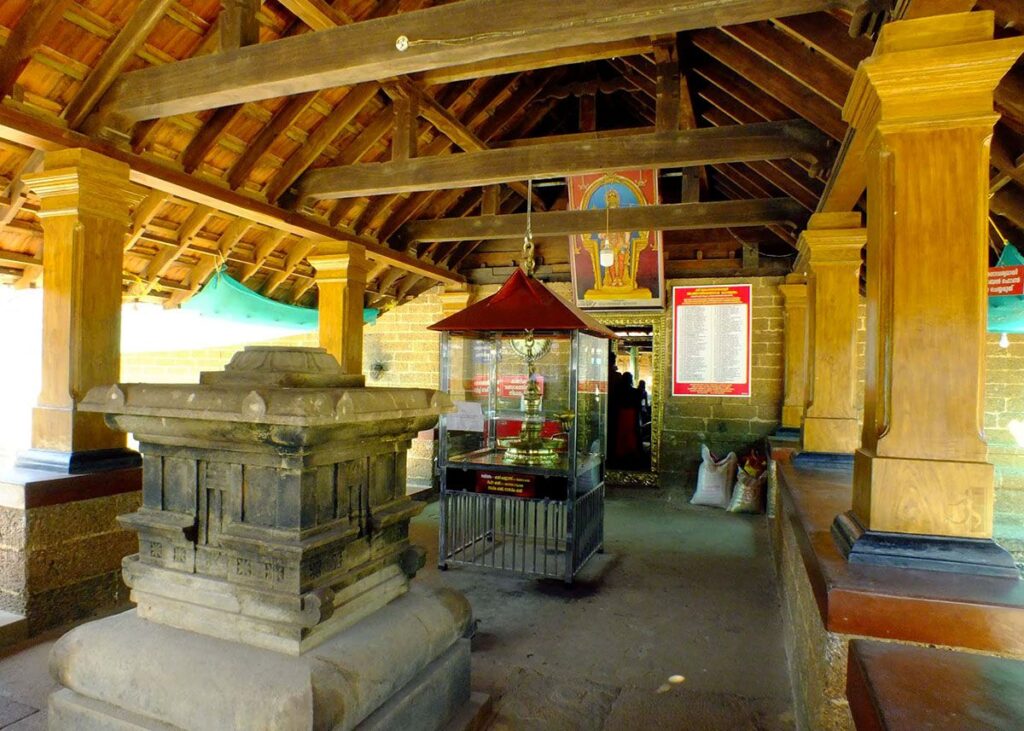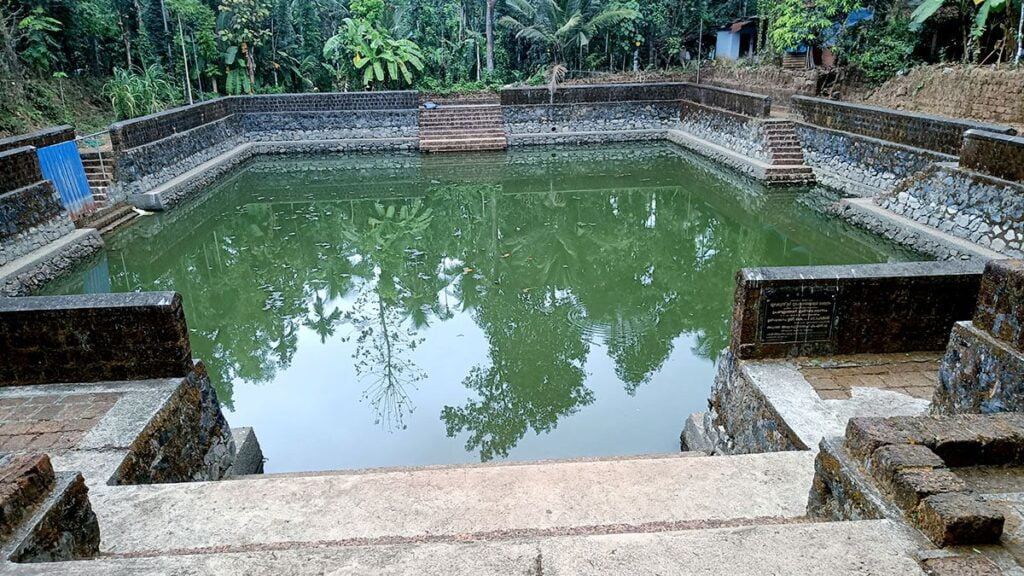Mridanga Saileswari Temple: Echoes of the Divine
The Mridanga Saileswari Temple is a famous Hindu temple located in Muzhakkunnu, Kannur district, Kerala, India. It is considered one of the 108 Durga temples of ancient Kerala, believed to have been installed by Parashurama, the sixth avatar of Lord Vishnu.

Contents
- 1 Mridanga Saileswari Temple History:
- 2 Legend of Mridanga Saileswari Temple:
- 3 Significance of Mridanga Saileswari Temple:
- 4 Myths of Mridanga Saileswari Temple:
- 5 Mridanga Saileswari Temple Timing and Rituals:
- 6 Places to visit near Mridanga Saileswari Temple:
- 7 FAQ:
- 8 How to reach Mridanga Saileswari Temple:
- 9 Google Maps:
Mridanga Saileswari Temple History:
Origin Stories and Age:
- There are two main origin stories:
- Parashurama’s Installation: The temple is believed to be one of the 108 Durga temples established by Parashurama, the sixth avatar of Vishnu. This suggests an ancient origin, possibly thousands of years old.
- Self-manifested Devi: Another legend suggests the Goddess Saileswari herself emerged from meditation as a Mridangam (drum) fell from heaven. A pit was created on the spot, which is said to be visible even today.
The Name “Mridanga Saileswari”:
- Mridangam Connection: The temple’s unique name “Mridanga Saileswari” combines “Mridangam” (a percussion instrument) and “Saileswari” (another name for Durga).
- There are interpretations that the temple might be dedicated to the “sound” aspect of the divine or the rhythmic nature of the universe.
- Another theory suggests the sound of the Mridangam might have played a role in the emergence of the Goddess.
Read More>> Ameda Temple of Naga Raja

Legend of Mridanga Saileswari Temple:
The Mridanga that Fell from Heaven:
- The legend begins with the arrival of a ‘Mridanga’, a percussion instrument, falling from the heavens onto the spot where the temple now stands. This celestial event is considered an indication of the presence of a powerful deity.
- Some believe the fallen object was a meteor shaped like a Mridanga, chosen by the divine as a sign.
Sage Parasurama and the Birth of the Temple:
- Sage Parasurama, the sixth avatar of Lord Vishnu, is said to have felt the presence of a powerful goddess upon witnessing the fallen Mridanga.
- He invoked the goddess into the rock where the Mridanga landed and established a temple to house her divine presence.
The Three Attempts to Steal the Idol:
- The legend adds another layer of intrigue with tales of attempted idol thefts. The temple idol depicts a four-armed Durga, Mridanga Saileswari Devi.
- Accounts say that thieves tried to steal the idol on three separate occasions, but each time, they were unsuccessful due to strange occurrences.
- Stories vary on the exact reasons, but some common themes include:
- Thieves experiencing sudden illness or uncontrollable urges to use the restroom.
- Finding the idol abandoned with a note pleading for its return to the temple.
- Inability to move the idol a significant distance.
These failed attempts further solidified the belief in the temple’s sanctity and the protective power of Mridanga Saileswari Devi.
Birthplace of Kathakali:
- Adding another layer to the temple’s rich history, some legends claim that Mridanga Saileswari Temple is the birthplace of the classical South Indian dance form, Kathakali.
- The temple’s association with this vibrant art form highlights its cultural significance.
Read More>> Attukal Temple | Attukal Bhagavathy Temple

Significance of Mridanga Saileswari Temple:
- Historical Significance:
- Believed to be one of the 108 Durga temples built by the legendary sage Parasurama.
- Estimated to be around 500 years old.
- Considered the family temple of the Kottayam royal family (Kannur) and associated with the valiant Pazhassi Raja who fought against the British.
- Religious Significance:
- Enshrines Goddess Durga in two forms: Mridangaleswari and Sreeporkali.
- Mridangaleswari represents knowledge and the arts, especially music.
- Sreeporkali is depicted as a warrior goddess ready for battle.
- Popular belief holds that the temple grants wishes and answers prayers of devotees who seek blessings with sincerity.
- Some consider it the birthplace of South Indian classical dance form Kathakali, as the Kottayathu Thampuran royal family composed famous Kathakali plays within the temple grounds.
- Enshrines Goddess Durga in two forms: Mridangaleswari and Sreeporkali.
- Uniqueness:
- The name “Mridanga Saileswari” stems from the legend of a Mridanga (drum) falling from heaven, marking the spot where the temple was built.
- Stories of failed attempts to steal the temple idol due to mysterious occurrences add to the temple’s mystique.
Read More>> Chottanikkara Temple Ernakulam Kerala

Myths of Mridanga Saileswari Temple:
- The Origin of the Temple:
- Myth 1 – The Descent from Heaven: This myth narrates that a piece of rock, perhaps a meteor, shaped like a Mridangam (drum) fell from heaven. Sage Parasurama, sensing a divine presence within, invoked Goddess Durga into the rock and established a temple to house her.
- Myth 2 – The Appearance of the Mridangam: Another version suggests that the Goddess herself appeared in the form of a Mridangam. Sage Parasurama then recognized her divine presence and enshrined her in this form.
- The Unwilling Thieves:
This captivating story recounts multiple attempts by thieves to steal the temple idol. However, each time, they were unable to take it far due to strange occurrences. The thieves experienced intense dizziness and disorientation, making escape impossible. They left the idol with a note expressing their inability to steal it and requesting its return to the temple.
Read More>> Sabarimala Temple: Abode of Lord Ayyappa
Mridanga Saileswari Temple Timing and Rituals:
DARSHAN TIMINGS
Morning: 05:00 Am to 12:30 Am
Evening: 05:00 Pm to 08:00 Pm
PUJA TIMINGS
Usha Pooja @ 07:00 Am [Dawn Prayer]
Uchha Pooja @ 11:00 Am [Noon Prayer]
Atthazha Pooja @: 07:15 Pm [Evening Prayer]
Deeparadhana: Performed at sunset
FESTIVALS:
- Navaratri
Navaratri, also known as Dussehra or Durga Puja, is a nine-day Hindu festival that celebrates the divine feminine. At the Mridanga Saileswari Temple, the celebrations for Navaratri are particularly grand and last for nine days. The focus of the first six days is on various aspects of the Goddess Durga. The last three days (Ashtami, Navami & Vijayadashami) are dedicated to the worship of Saraswati, the Goddess of knowledge and learning. Vidyarambham, the initiation ceremony for children into the world of learning, is considered highly auspicious to perform on Vijayadashami, the tenth day of Navaratri.
- Pooram Mahotsavam
Pooram Mahotsavam is a vibrant festival celebrated in the Malayalam month of Meenam (March-April). The festival is marked by a spectacular display of traditional art forms like Theyyam and Poorakkali. Theyyam is a ritualistic performance where performers wear elaborate costumes and makeup to depict various deities and mythical beings. Poorakkali is a colorful martial art form, traditionally performed by men, that represents a mock war. The energy and enthusiasm during Pooram Mahotsavam in the Mridanga Saileswari Temple create a truly unforgettable experience.
Read More>> Sree Padmanabhaswamy Temple: 8th CE Spiritual Wonder & Mystery

Places to visit near Mridanga Saileswari Temple:
- Sri Kukke Subramanya Temple:
- Located around 60 kilometers from Mridanga Saileswari Temple, this renowned Hindu temple is dedicated to Lord Subramanya.
- Adichunchanagiri Math:
- Situated about 70 kilometers away, the math is a spiritual and educational center with a picturesque setting.
- Shravanabelagola:
- Approximately 80 kilometers from the temple, Shravanabelagola is famous for its colossal Gommateshwara Bahubali statue and Jain heritage.
- Biladwara Cave:
- Explore the natural beauty and historical significance of Biladwara Cave, located around 30 kilometers away.
- Yagachi Dam:
- Enjoy a scenic getaway at Yagachi Dam, situated about 40 kilometers from Mridanga Saileswari Temple.
- Sri Male Mahadeshwara Swamy Temple:
- This temple, around 90 kilometers away, is dedicated to Lord Mahadeshwara and is surrounded by lush greenery.
- Bhadra Wildlife Sanctuary:
- Nature enthusiasts can visit Bhadra Wildlife Sanctuary, approximately 80 kilometers from the temple, for a chance to spot diverse flora and fauna.
- Chennakesava Temple, Hassan:
- Explore the exquisite Hoysala architecture at Chennakesava Temple, located around 60 kilometers from the Mridanga Saileswari Temple.
- Manjarabad Fort:
- Discover the historical Manjarabad Fort, situated about 90 kilometers away, known for its unique star-shaped architecture.
- Sakleshpur:
- A scenic hill station around 80 kilometers from the temple, Sakleshpur offers lush landscapes and pleasant weather.
FAQ:
General Information
- Where is the temple located? The Mridanga Saileswari Temple is situated in Muzhakkunnu, Kannur district, Kerala, India.
- What is the presiding deity? The main deity is Mridanga Saileswari, a four-armed incarnation of Goddess Durga.
- Is the temple historically significant? Yes, the temple is considered one of the 108 Durga temples of ancient Kerala, believed to be installed by Parashurama, the sixth avatar of Lord Vishnu. It is also the family deity of the Kannur royal dynasty and the Pazhassi Raja, a legendary figure in Kerala’s history.
Deity and Worship
- What form does the Devi take? Mridanga Saileswari appears as a four-armed Durga, holding a conch and discus in her upper hands, while blessing devotees with her lower right hand and resting her lower left hand on her waist.
- What other deities are worshipped here? The temple complex houses a shrine dedicated to Porkali, another manifestation of the Devi. Devotees also worship Saraswati, the Goddess of knowledge, music, and arts.
- What are the offerings made at the temple? Neyvilakku (ghee lamp) is the primary offering. The temple accepts online puja bookings for various poojas performed throughout the day, including Usha Puja (morning prayer), Uchha Pooja (noon prayer), and Athazha Pooja (evening prayer).
Visiting the Temple
- What are the temple timings? The temple is generally open from 5:00 AM to 12:30 PM and 5:00 PM to 8:00 PM. It’s always a good idea to check the temple website or social media pages for any updates on timings during special occasions or festivals.
- Is there a dress code? While there’s no strict dress code, devotees are expected to dress modestly, covering shoulders and knees.
- How to reach the temple? Muzhakkunnu is well-connected by road. You can take a bus, taxi, or car to reach the temple.
Festivals and Events
- What are the major festivals celebrated at the temple? The two main festivals are Navaratri and Pooram Mahotsavam. Navaratri is a nine-day celebration of the divine feminine, while Pooram Mahotsavam features vibrant displays of traditional Kerala art forms like Theyyam and Poorakkali.
How to reach Mridanga Saileswari Temple:
- By Air:
- The nearest airport is [Name of the Airport], located approximately [X] kilometers away from the temple. From the airport, you can hire a taxi or use public transportation to reach the temple.
- By Train:
- The nearest railway station is [Name of the Railway Station], situated about [Y] kilometers away. Trains from major cities connect to this station. Once you arrive, you can take a taxi or use local transportation to reach the temple.
- By Road:
- If you’re traveling by road, the temple is well-connected through a network of highways. Use GPS or follow road signs to reach the temple. You can also inquire locally for the best route.

One Comment